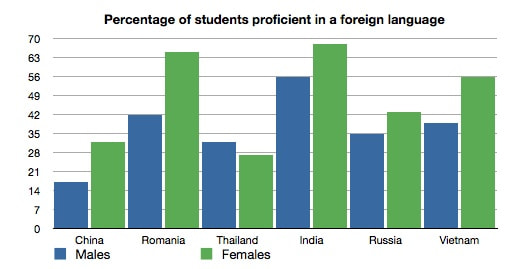
How to Describe a Bar Graph in IELTS Writing Task 1?
In the IELTS writing task 1, bar graph is one of the common questions you may find in your exam. There can be a single bar graph question or a combination of two or more bar graphs. Otherwise, it can also be very likely that you find combination of a bar graph and a line graph, a bar graph and a pie chart or a bar graph and a table. Whatever the type of bar graph question it is, you should know how to describe it properly. Let us know the steps to follow in order to describe a bar chart:
Step 1: Read Question and Select Information
Reading the IELTS writing task 1 question is the foremost step to follow for understanding it thoroughly. Without reading it carefully, it is impossible to write effectively. Hence, the basic idea of what the essay question is about should be very clear to you. While reading question and scanning the bar graph diagram, keep your eyes on selecting the given information.
For example, by reading the question statement, you can paraphrase it to write introduction. Then, you can look at the heading of bar graph question to get precise idea about it. After this, look at the x-axis and y-axis for finding out the figures, differences in those figures, labels of bar graph and the units (which you must write alongwith mentioning a figure).
Step 2: Start Writing Introduction
Now that you have completely understood what information is given in the IELTS writing task 2 bar graph question, you can now be able to start writing introduction because introduction is nothing but the main idea of the question itself.
Step 3: Analyse the Question – Compare and Contrast
In order to write the key features of a bar graph, it is important that you properly analyse the bar graph diagram. First of all, in case of multiple bar graphs of different colors, you can check every bar graph from start level to end level by noticing the values in x-axis and y-axis. At this stage, find out how the bar graph is progressing in increasing, decreasing, constant or fluctuating way and notice the overall trend of the bar graph as well.
Next, you can start making out comparisons among the bar charts and see if there are some similarities or differences which are very noticeable. Listing out such features in IELTS writing task 1 is very important in order to score high. For example, you may notice that two bar graphs are at the same level, a bar graph for a particular label is constantly increasing etc.
Step 4: Start Writing Body Paragraph(s)
Once you are done analysing your bar graph question in IELTS writing task 1 in around 5 minutes, you can now start writing body paragraph. You may write a long body paragraph or divide it into two small body paragraphs but make sure that your ideas are in flow and that you are writing logically. Writing everything randomly would confuse not only you as you may miss out any important detail, it would also be confusing for the examiner to understand. Also, make sure you are using words such as whereas, on the other hand etc. to connect your sentences together.
Step 5: Write your Conclusion/Summary
Main summary of the bar graph question is a must which you may write after introduction or at the end. It is nothing but the very noticeable overall trend in the diagram. Other in-depth features that you may notice can be written in the body paragraph and also ensure that you are not writing the same features in conclusion that you have already written in the body paragraph, to avoid repetition.




